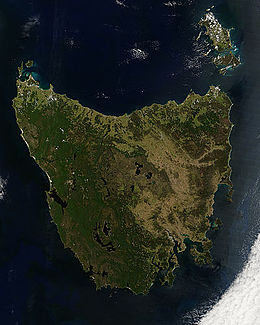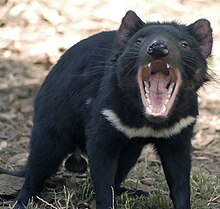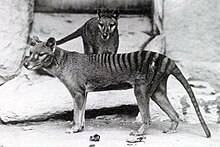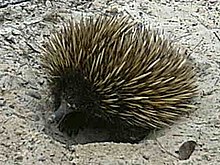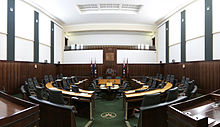Tasmania
| flag | coat of arms |
|---|---|

|
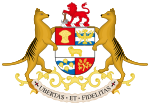
|
| ( Details ) | ( Details ) |
| Basic data | |
| Part of the state of: | Commonwealth of Australia |
| Capital : | Hobart |
| Area : | 68,400 km² |
| Residents : | 534,300 (2019) |
| Population density : | 7.53 inhabitants per km² |
| ISO 3166-2 : | AU-TAS |
| Time zone: | AEST ( UTC +10) |
| The highest point: | Mount Ossa 1617 m |
| Official Website: | www.tas.gov.au |
| politics | |
| Governor : |
Kate Warner (since December 2014) |
| Prime Minister : |
Will Hodgman ( LP ) (since March 2014) |
| Parliament seats: | 5 ( House of Representatives ) 12 ( Senate ) |
| Map: Location of Tasmania | |
| Map: Tasmania | |

|
|
Tasmania ( English Tasmania , in the reconstructed Aboriginal language palawa kani lutruwita and in Australian-English often Tassie ; until the end of 1855 Van Diemens Land ) is an island belonging to the state of Australia on the eastern edge of the Indian Ocean , which is about 240 km located south of mainland Australia. The term also stands for the Australian state of the same name , which also includes several small, mostly uninhabited archipelagos in the region beyond the main island of Tasmania. Its capital and largest city is Hobart , which is Launceston's second largest city .
geography
As the largest island of the Australian Confederation, Tasmania covers 68,400 km² and comprises 0.89% of the total area of Australia. Without the offshore islands the area of the main island is 64,519 km² and has a length of 296 km from north to south and a length of 315 km from east to west.
The Bass Strait , which separates the island from mainland Australia, is flanked in the northwest by King Island , on the northeast tip by Flinders Island . The landscape is dominated by mountains and plateaus up to around 1600 m altitude. The highest point is Mount Ossa (1617 m).
Tasmania is between 40 ° and 44 ° south latitude and between 144 ° and 149 ° east longitude. The island is located on the southern tip of the Australian continental shelf and is almost the size of Ireland. It is by far the largest of the over one hundred islands in the Bass Archipelago.
There are still a relatively large number of natural landscape types there. About a quarter of the island is a UNESCO - World Heritage designated to 37%, there is the island national parks . The landscape on Cradle Mountain and the untouched and sometimes inaccessible wilderness of the southwest are particularly impressive .
Macquarie Island , 1,300 km south, is also part of the state of Tasmania.
climate
The Tasmanian climate is oceanic - subtropical in the northeast and temperate in the southwest . The winters are therefore relatively mild. On the other hand, the island is one of the few land masses in the area of the so-called Roaring Forties . All seasons can be lived through in one day, especially on the plateaus. Although Tasmania is at the same latitude as Istanbul , Rome and Barcelona in the northern hemisphere, the climate is comparatively a bit cooler. Due to the mountain ranges in the west of the island, there is significantly more precipitation on the west coast, which is why different forms of rainforest shape the landscape there. The sun usually shines in the middle and east of the island.
| Hobart | ||||||||||||||||||||||||||||||||||||||||||||||||
|---|---|---|---|---|---|---|---|---|---|---|---|---|---|---|---|---|---|---|---|---|---|---|---|---|---|---|---|---|---|---|---|---|---|---|---|---|---|---|---|---|---|---|---|---|---|---|---|---|
| Climate diagram | ||||||||||||||||||||||||||||||||||||||||||||||||
| ||||||||||||||||||||||||||||||||||||||||||||||||
|
Average monthly temperatures and rainfall for Hobart
Source: WMO
|
|||||||||||||||||||||||||||||||||||||||||||||||||||||||||||||||||||||||||||||||||||||||||||||||||||||||||
As an island, Tasmania is under maritime influence, so the microclimate is regionally more differentiated. The seasons, shifted by six months to the northern hemisphere, are far less pronounced. The winters are mild with average temperatures of 0.5 ° C to 10.5 ° C and the summers are rather cool with 9 ° C to 19 ° C. Nevertheless, night frosts can occur almost everywhere on the island in winter and snow can fall at high altitudes at any time of the year . Even in summer the mountain tops can be covered with snow above 1200 meters, in winter above 600 meters. At such high altitudes, the temperature can drop to −1 ° C in July and to extreme values down to −10 ° C. The relatively mild climate is, however, characterized by abrupt weather changes, the often strong wind and the high humidity.
The distribution of precipitation in Tasmania is also less influenced by seasonal fluctuations than by the prevailing wind direction. In contrast to mainland Australia, where the southeast trade wind exerts its influence, the island is exposed to strong westerly winds all year round. These roaring forties rule the entire southern hemisphere at this latitude and meet Tasmania here unchecked by land masses (the closest is Patagonia ). The western part of the island is both more humid and cooler and also has fewer hours of sunshine per year than the east. These temperature differences are exacerbated by the influence of a warm ocean current in the east and a cold one from the Antarctic in the west of Tasmania.
The humid wind in the west ensures annual precipitation of over 1500 mm with peaks of up to 3800 mm. In the east, values around 1500 mm per year are the exception, in some cases only values around 400 mm are achieved. Put simply, one can say that the annual rainfall in Tasmania is continuously decreasing in a west-east direction. Compared to the most arid continent on earth - Australia - even these values are still high in the east of the island.
Flora and fauna
The Tasmanian flora and fauna are closely linked to Australia's geological past. From a geological point of view, the Australian continent occupies a special position due to its 50 million years of isolation, which has had a lasting effect on its biocenosis . This separation is responsible for the large number of endemic species, which often have a great phylogenetic age. In Tasmania, this aspect is reinforced by the separation from mainland Australia around 12,000 years ago, as non-Australian influences were even less important here.
The main features of the flora and fauna of Tasmania go back to the supercontinent of Gondwana . Gondwana reached its greatest extent at the beginning of the Permian and began to break up into the current continents of the southern hemisphere in the Jurassic . The order of this division has significantly shaped the position of the Australian biosphere in the ecological structure of the world. Successively, the Australian landmass was separated from what was later to be Africa , India , and New Zealand , but only in the Eocene from Antarctica. This is the reason for the fact that the Australian biosphere most closely resembles parts of the New Zealand and South American regions. Because during the Eocene, South America and Australia were still connected by the land mass Antarctica . This theory is supported by studies of the recent flora and fauna as well as by fossil findings. Since separating from Antarctica, Australia has been isolated from the other continents for more than 50 million years. Of course, the Australian biosphere has since adapted to the ecological conditions and changes over the course of millions of years, and yet it still clearly resembles the former flora and fauna of Gondwana.
flora
The vegetation is determined in the northwest by subtropical wet forests , which slowly change into temperate rainforests to the south . In the southwest and north there are buttongrass and moorland . On the vast plateaus we encounter alpine mosses and higher plant species. Due to its isolated location from the mainland, around 20 percent of the 1500 higher plant species are endemic . Due to the different climatic and geographical conditions, the western half of the island also differs greatly from the east in terms of flora. The wet forests in the western part are similar to those of southern Chile and New Zealand . In the east of Tasmania, dry and sparse hardwood forests of Australian character prevail. The latter are characterized by hundreds of different acacia and eucalyptus species , which, as in parts of Australia, dominate the entire remaining flora. Like all of Australian flora, they also show a variety of different evolutionary adaptations. The Australian-style forest thins out increasingly at higher altitudes . Above an altitude of 900 meters in the north and 600 meters in the south, the forests often merge into extensive moorland.
The cool, temperate wet forest of Western Tasmania is dominated by endemic southern beech species ( Nothofagus spec.), Which can grow up to 40 meters high. Like almost all tree species in Tasmania, they are also evergreen. The tallest deciduous trees in the world grow in these forests, such as the giant eucalyptus (up to 100 m high) or the stringy barque (up to 90 m high). These giants protrude far beyond the forest canopy as overhangs . Primeval tree species that are unparalleled also grow underneath, such as the Celery-top-Pine , a conifer without needles with leaf-like stems, the Huon-Pine ( Lagarostrobos franklinii ), which can live for over 2000 years, or the Dicksonia tree ferns with their wide fronds. Due to the eucalyptus species that occur, these forests are strictly speaking not real rainforests , although all other criteria apply. The pronounced storey structure of this forest and its dense undergrowth often make it impenetrable. In the extensive dune landscapes of the sandy beaches, heat and drought-resistant bushes, shrubs and grasses predominate.
- Nature in Tasmania
Blooming acacia bush
Wine route in Tamar Valley
Even before the arrival of the Europeans, large areas of Tasmania were shaped by the influence of the native island population. In this way, for example, the damp reed landscapes with their reeds , grass and hedges were created, which penetrate the rainforest and the partly park-like character of some eucalyptus and acacia forests.
In today's agriculture, viticulture plays an important role. Much of the wine - around 40 percent - is made in the north of the island, in the Tamar Valley on the Tamar Valley Wine Route.
fauna
Tasmania's wildlife is closely related to that of Australia. The latter, like the vegetation, is characterized by endemics . Marsupials are the dominant land creatures, of which the extinct pouch- wolf (or marsupial tiger, tylacine) is a well-known example. The wombat (a pouch bear) is represented as well as numerous species of kangaroo .
Since many of the European animal species introduced to Australia (especially the red fox ) as well as the secondary wild dingo native to the mainland never made it to Tasmania, many animal species that became extinct on the mainland survived there, including bag-headed badgers and small wallaby - Species. Another well-known example of an endemic species of Tasmanian animal is the Tasmanian devil , which has also become extinct on mainland Australia.
As in mainland Australia, there are various types of climbing , ring and gliding bags to be found here. Like koalas or kangaroos, they are marsupials and have always been part of the prehistoric fauna of Australia. The predominant marsupials also go back to Gondwana . The Australian flightless ostrich, the great emu , also dates from this era. The main representatives of the Australian animal world, the marsupials, have occupied all other habitats with the exception of the water ecosystem . The marine fauna of Tasmania differs only slightly from that of other regions of this latitude.
In the country, however, the marsupials (Marsupialia) were largely spared from outside Australian influences. Even the extremely species-rich bird fauna - although less bound by boundaries - is made up of genera that are 90 percent endemic. If you only look at the bird species, this is even 95 percent. In pre-European times in Australia, the selection of higher mammals (placental animals ) was limited to rodents and bats ( bats and flying dogs). They probably came from the north during the Miocene .
The fauna of Tasmania is much poorer in species than that of Australia. Only about one fifth of the marsupial, one tenth of the rodent and one seventh of the bat species in Australia are found there. Flying foxes and gliders did not penetrate as far as Tasmania either. However, this species poverty should not hide the high population density of terrestrial animals in Tasmania, which is complemented by the diverse coastal and marine fauna.
In contrast to the Tasmanian bagwolf , the Tasmanian devil - presumably due to the lack of the dingo in Tasmania - was able to survive until today. The Tasmanian pouch-wolf ( Thylacinus cynocephalus ) was often called the Tasmanian tiger because of its dark brown-yellowish striped fur. Its Latin name means 'bag dog with a wolf's head', which was pretty close to its appearance. With a back length of around 1.20 meters, it was roughly the same size as our European wolf and was able to kill larger prey. He usually hunted in the dark or at least in the twilight and was considered slow and a little clumsy. Probably the dogs released into the wild in the early colonial times were his undoing. But the shepherds also pursued him, so that he was very rare even in the 1830s. At the end of the 19th century it was already an extremely popular hunting trophy. It is uncertain when exactly it became extinct, and eyewitnesses keep appearing who claim to have seen individual specimens. Although Tasmania's rangers are currently tasked with finding clues, these rumors have so far remained unconfirmed.
The platypus (Platypus) and Tasmania short-beaked echidna ( Tachyglossus aculeatus setosus ) from the subclass of Prototheria whose phylogenetic position until today it is unclear among the most bizarre representatives of the Australian or Tasmanian fauna. Both, although mammals, are cloacents due to the lack of specific sex organs, just like birds or reptiles.
The most important game game of the pre-European population were the kangaroo , the wombat and the fox kusu . Of the few species of kangaroo compared to Australia, the gray-brown Eastern gray giant kangaroo ( Macropus giganteus ) was the most popular prey. It grows up to five feet and a half and has appeared in large herds. In the smaller kangaroo species, the 'wallaby' was particularly important as prey. The bare-nosed wombat ( Vombatus ursinus ) lives in underground cave systems and was used as a rich source of meat. The hunt for the fox kusu ( Trichosurus vulpecula ) was widespread but very arduous, as it usually resides in high treetops.
In addition to the emu, another flightless ratite was hunted. The Tasmanian grouse ( Tribonyx mortierii ) corresponds in its shape to our pond rail . Otherwise, the extremely diverse bird fauna of the Tasmanian inland was of no importance as prey. Of the reptiles , which are the most successful group of animals in Australia alongside the marsupials, only the larger species were consumed in Tasmania.
Only three of Australia's 140 species of snakes are native to the island. There are the black tiger otters , the Australian copper heads and the white lipped otters . All three belong to the Elapidae group and are all poisonous. In Tasmania, snails and leeches play a bigger role than on the dry continent.
Coastal and marine fauna were of vital importance in Tasmania. As already indicated, it does not differ significantly from the fauna of other parts of the world. In the sea, which is rich in fish, there were also a variety of marine mammals: dolphins , whales , elephant seals , seals and harbor seals . The large numbers of mussels , crabs , crabs, and lobsters were popular foods. Seabirds nested in large numbers on the coasts, some of which were only found seasonally as migratory birds: cormorants , ducks , geese , black swans , various species of coot, albatrosses , herons , boobies and the 'mutton bird' ( Ardenna tenuirostris ), the short-tailed bird. Shearwater , which played a central role in the food supply of the coastal population.
In this context, the megafauna that became extinct at the end of the Ice Age around 25,000 to 15,000 years ago (Flood 1995: 192; cf. Scarre 1990: 68) (Fig. 5). This also contained larger forms of recent animal species. Other genera disappeared forever when they became extinct; such as the Diprotodon , which reached the size of a rhinoceros . The forms of the Tasmanian devil and emus at the time were considerably larger. Some species of kangaroo reached a height of three meters and wombats the size of a donkey are also recorded.
The reasons for the extinction are not yet clearly understood; however, there is some evidence that the pre-European population was not uninvolved (Flood 1995: 136f, 281; Lourandos 1997: 98–111; Wilpert 1987: 21). Contrary to other claims, the Aborigines have also left traces in their habitat. A phenomenon that - long denied - is also increasingly being confirmed by hunter populations in other parts of the world. In this context, a lack of control of nature should not be equated with a lack of lasting influence. The endeavors not to strain their resources excessively did not always succeed, even for poachers. Another example of this could be the extinction of an elephant seal ( Mirounga leonina ) on Tasmania, for which Rhys Jones blames the prehistoric population (Jones 1966/67; cf. Mulvaney and Golson 1987: 90).
population
The Tasmanians did not have the technology of maritime navigation and therefore developed independently from the Aborigines of mainland Australia. It is estimated that when the British arrived in 1803, about 3,000 to 5,000 indigenous people lived in Tasmania. They were completely exterminated by the British by 1865, the native languages becoming extinct with them. However, there are still several thousand descendants of mixed relationships between Europeans and indigenous people.
According to official statistics, in 2013 Tasmania had 514,000 inhabitants. This corresponds to a population density of 7.5 inhabitants per km².
politics
| Parties and seats in the Parliament of Tasmania | ||
|---|---|---|
| Political party | House of Representatives | senate |
| Liberal Party of Australia | 15th | 2 |
| Australian Labor Party | 7th | 1 |
| Australian Greens | 3 | 0 |
| Non-party / independent | 0 | 12 |
| Source: Tasmanian Electoral Commission | ||
Like every Australian state (with the exception of Queensland ) Tasmania also has a bicameral parliament. The executive is a cabinet headed by the prime minister . The Australian state governments are largely responsible for education, health, justice, police and transportation.
The head of state is officially Queen Elizabeth II. The head of the British crown is represented by the Governor of Tasmania . The governor is appointed by the British Queen on the proposal of the Prime Minister. In fact, it has mainly representative tasks.
Administratively, Tasmania is divided into 29 Local Government Areas ; see Local Government Areas in Tasmania .
history
Early history
Tasmania was settled from the north at least 35,000 years ago via the mainland connection to Australia at the time. The flooding of the Bass Strait about 12,000 years ago isolated the Tasmanians from the continent's Aborigines so that cultural and technical innovations could no longer be exchanged. At the time of the European discovery, there were probably between 4000 and 6000 Tasmanians living on the island. Due to the long isolation, the Tasmanians retained a Stone Age culture as hunters and gatherers. Apart from simple tools made of stone, bone and wood, they had no technology whatsoever.
Discovery by the Europeans
In 1642 the Dutchman Abel Tasman sailed with the ship Heemskerck and the Fleute Zeehaen along the south coast of Australia and discovered this area as well as New Zealand. The trip took place on behalf of the Governor General of the Dutch East Indies , Anton van Diemen , after whom he named the newly discovered country (Van Diemens Land) . Tasman assumed, however, that it was a peninsula on the Australian continent. In 1772 the British explorer Tobias Furneaux went ashore in the southeast of the island. A year later she was also visited by the French explorer Marc-Joseph Marion du Fresne . In 1798, when the British captain Matthew Flinders discovered the Bass Strait , it was an island.
Shortly after the founding of the British colony of New South Wales on the Australian mainland , a French expedition landed in Tasmania in 1792 to explore the country. In 1803 the British built Risdon Cove on the Derwent River, the first permanent European settlement in what is now Tasmania. A year later they gave up and founded Hobart Town ( Hobart ) in the south and Port Dalrymple (now George Town ) in the north of the island. In the early years, what was then Van Diemens Land was primarily intended as a British penal colony . The first European residents therefore consisted of convicts and their guards. Especially serious criminals were brought to Van Diemens Land, as the island was easier to monitor than the mainland colonies due to its smaller size. Between 1803 and 1853 around 75,000 convicts were brought there.
In 1825 Van Diemens Land was declared an independent colony, independent of New South Wales, with its own parliament and judiciary. From 1836 to 1843 the navigator and north polar explorer Sir John Franklin was British governor of the island.
In 1856 the Australian colonies of Great Britain were granted extensive autonomy under the Australian Colonies Government Act , including the right to have their own constitution and government. In the same year it was renamed Tasmania.
Tasmania has been part of the Australian Confederation since Australia's independence in 1901 . In 1917 the British King George V donated the national coat of arms with two bag wolves as shield holders.
Genocide against the indigenous population
With the arrival of the Europeans, a systematic extermination of the indigenous population began. By declaring martial law , the natives were in fact released to be shot; crimes were not punished. Massacres were not only carried out by settlers (e.g. Cape Grim massacre , Black War ), but also by sealers who temporarily set up camp on the island and terrorized the local population. Also introduced diseases led to the fact that the number of the indigenous people decreased rapidly.
Around 1830, then-Lieutenant Governor George Arthur decided that the remaining natives needed to be brought together in a common area. The attempt to forcibly round up the natives ( Black Line ), however, failed. The English preacher George Robinson , who was appointed Protector of Aborigines in 1839 , subsequently succeeded in convincing the at that time only 300 indigenous people to allow themselves to be deported to Flinders Island without resistance . Most of them died there of malnutrition and diseases within a few years. The settlement was dissolved in 1849. Truganini (1812–1876) and Fanny Cochrane Smith (1834–1905) are considered to be the last survivors of the Tasmanian indigenous population. The Tasmanians of today are all descendants of Tasmanians and Europeans, many of Fanny Cochrane Smith, who was married to a man of European descent. They consider themselves legitimate descendants of the Tasmanians, but their status is controversial.
environmental Protection


For most of the 19th and 20th centuries, Tasmania had a policy of resource exploitation. Logging, mining, and damming rivers to harness hydropower were major economic drivers. Protests by environmentalists against the planned flooding of Lake Pedder for a hydropower plant led to the founding of the United Tasmania Group (UTG), the world's first Green Party , in 1972 . In 2004, the Australian forest group Gunns announced the construction of the world's largest pulp mill in Tasmania. This project has sparked a fierce struggle to protect the Tasmanian primeval forests, which are unique in the world due to the many endemic species. After all, an impressive 40% of the land area in Tasmania is protected, especially in the western part of the island. There is also the UNESCO World Heritage -Schutzgebiet Tasmanian Wilderness . But the potentially economically interesting forests are not protected and in 2014 Australia even submitted the application, which was rejected by the UN, to outsource parts of the World Heritage area and use them again for logging.
Universities
- University of Tasmania (UTAS), Hobart
various
Tasmania was the godfather of a racing series for formula cars in the 1960s , the Tasman series . In Arno Schmidt's novel Abend mit Goldrand (1975), Tasmania is the utopian goal of a chiliastic gang. The Tasman Highway and the Midland Highway connect the cities of Hobart and Launceston. The Tasman Highway is one of the longest highways in Tasmania with a length of 410 kilometers. In addition, the old British colony Van Diemens's Land is sung about by the Irish rock band U2 from the perspective of a prisoner in the song of the same name from 1987. One of the most famous Tasmanians is the actor Errol Flynn (1909–1959). The writer Richard Flanagan is Tasmanian.
See also
- Railroad in Tasmania
- Commonwealth Heritage List in Tasmania
- List of governors of Tasmania
- List of highways in Tasmania
- List of Prime Ministers of Tasmania
- Local Government Areas in Tasmania
literature
- Dirk Halfmann: The Tasmanian Aborigines - Source-critical inventory of previous research results , GRIN Verlag, 1998, ISBN 3-638-10031-6 .
- Lloyd Robson, Michael Roe: A Short History of Tasmania , 2nd edition, Oxford University Press, Melbourne 1997, ISBN 0-19-554199-5 .
- Tasmania . In: Meyers Konversations-Lexikon . 4th edition. Volume 15, Verlag des Bibliographisches Institut, Leipzig / Vienna 1885–1892, p. 528.
- Nicholas Shakespeare: In Tasmanien (novel) , 2005, Marebuchverlag, Hamburg, ISBN 3-936384-40-1 .
Web links
- Tasmanian government website with many links to pages from and about Tasmania
- Geography, climate, flora and vegetation of Tasmania
Footnotes and individual references
- ↑ 3101.0 - Australian Demographic Statistics, June 2019 , accessed January 6, 2020.
- ↑ Kristyn Harman: Explainer: how Tasmania's Aboriginal people reclaimed a language, Palawa kani. Retrieved May 29, 2019 .
- ^ Tasmanian Aboriginal Center - Official Aboriginal and Dual Names of places. Retrieved May 29, 2019 .
- ↑ Barbara Boron: Nature and cultural tourism business destination management using the example of Tasmania. GRIN Verlag, 2006, ISBN 978-3-638-46258-7 , p. 10. limited preview in Google book search
- ^ Tasmania, the Name. Retrieved May 29, 2019 .
- ↑ Parks & Wildlife Service Tasmania Reserve Listing , accessed October 6, 2010
- ↑ a b Article “The Battle for Tasmania's Primeval Forests” in Robin Wood Magazine No. 103 / 4.09
- ↑ Our Region , online at: tamarvalleywineroute.com.au / ...
- ^ Convicts and the British colonies in Australia. (No longer available online.) Australian Government February 17, 2010, archived from original January 27, 2012 ; Retrieved December 3, 2011 . Info: The archive link was inserted automatically and has not yet been checked. Please check the original and archive link according to the instructions and then remove this notice.
- ^ Saving Tasmania's forests on Al Jazeera , June 12, 2014, accessed June 17, 2014
- ^ Karl Mathiesen: UN rejects Australia's 'feeble' bid to strip Tasmanian forest's heritage status . The Guardian , June 23, 2014.
Coordinates: 42 ° 3 ′ S , 146 ° 37 ′ E


